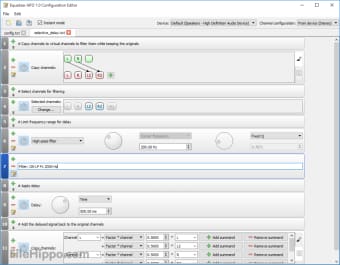
- #APO EQUALIZER NOISE SUPPRESSION FOR MICROPHONE HOW TO#
- #APO EQUALIZER NOISE SUPPRESSION FOR MICROPHONE INSTALL#
- #APO EQUALIZER NOISE SUPPRESSION FOR MICROPHONE CODE#
- #APO EQUALIZER NOISE SUPPRESSION FOR MICROPHONE PC#
- #APO EQUALIZER NOISE SUPPRESSION FOR MICROPHONE PLUS#
from CD player or other sources) and I need to playback it (after filters correction) to the soundcard output, no way to listen anything. The problem arises when I try to use it capturing music from the soundcard input (e.g. if I change the attenuation of a preamplifier block).
#APO EQUALIZER NOISE SUPPRESSION FOR MICROPHONE PC#
Same thing if I reproduce music from the PC (when EQ APO is switched ON it applies correctly its filters and I can clearly listen to its intervention, e.g. I'm playing with Equalizer APO to implement a free DSP under Windows for room correction (just for test purposes) and I have the problem I will try to explain below.ĮQ APO works fine and is correctly installed on my PC (I already read all the troubleshooting posts), in fact if I loopback the output to input (tried with both analog out -> in and with TOSLINK out -> in) of my external soundcard and I measure the frequency response sweeping with REW I can clearly see its intervention when switched ON (and it works as supposed to do).

Test your mic to see if the situation has improved.Second post here, and beg your pardon in advance if this argument has already been discussed (but I found nothing about the solution I need). That's it! You're done! Re-open Configurator for EQ APO and open the reafir panel.
#APO EQUALIZER NOISE SUPPRESSION FOR MICROPHONE CODE#
Select all of the code between the quotes (again, careful not to select the quotes themselves!) and paste the giant dump of data we copied from OBS. Right near the top, you SHOULD see another Chunk Data followed by a "quote" and some more code. Again do NOT include the quote!ĪAAAAAAAAAAAAAAAAA is how I feel just looking at this! Step 5: Paste into EQ APOĬopied that giant mess? Next, open EQ APO's folder and open the config.txt with notepad again. Make sure you copy all the way to the last quote mark. Make sure you do NOT copy the quotes OR the colon. It's going to be a LOT of random letters and numbers. Not far after that should be an area labeled "Chunk Data"Ĭopy ALL THE CODE after the colon and BETWEEN THE "QUOTES". Press control-F and find "VST 2.x" it should look like this: json file (Mine is named Untitled, yours probably will be also unless you renamed your scene) with notepad. Which is a fancy way of saying go to your primary hard drive, find Users\\Roaming\obs-studio\basic\scenes\ It is located at %appdata%\obs-studio\basic\scenes.json

Probably the hardest part of this whole process is getting the chunk data. We're done with that for now! Step 4: Copy Chunk Data Uncheck the build noise profile button (quietly) and close the window and OBS. Make sure the room is absolutely silent during the noise profile build. Next, click "Automatically build noise profile" - Let it sit for a few seconds and you should end up with a graph that looks something like the above. This should look familiar now! As you did in the last tutorial on using EQ APO to reduce background noise, use the drop-down menu to select Subtract. Basically, re-install it toĬlick "Open Plugin Interface.
#APO EQUALIZER NOISE SUPPRESSION FOR MICROPHONE INSTALL#
OBS looks only at certain directories, a list of where you should install reafir is here. If you do NOT see a list of plugins it is probably because reafir is installed to the wrong directory. Anything worth doing is worth overdoing, I guess? Then click open interface.Īpparently, I have reafir installed twice, so everything is doubled. Click on it and you should see a nice list of filters, select reafir_standalone. You should now have a drop-down menu on the top right.
#APO EQUALIZER NOISE SUPPRESSION FOR MICROPHONE PLUS#
A window should pop up, on the bottom left is a plus sign. Then, right click on the source again and select Filters. Make sure your mic is correctly selected as the input source. Next, right click on the newly created audio source and select Properties. Right click on the Sources and select Add -> Audio Input Capture. You don't need to configure any account info after installing, just skip it for now. OBS so far is the easiest and best way I have found to build and copy ReaFir data, plus it's free. We are assuming you have everything all set from that post, so if you don't, go back to our post on reducing noise with EQ APO.
#APO EQUALIZER NOISE SUPPRESSION FOR MICROPHONE HOW TO#
This is a continuation from our earlier post, how to reduce noise with EQ APO and Reafir.

So long as you don't change mics, recording location, or hardware you really only need to do this once and re-do it when you make major changes. However, you CAN build one in OBS and import it into EQ APO. You can't actually build a noise profile automatically in EQ APO.

The title of this post is a BIT misleading.


 0 kommentar(er)
0 kommentar(er)
